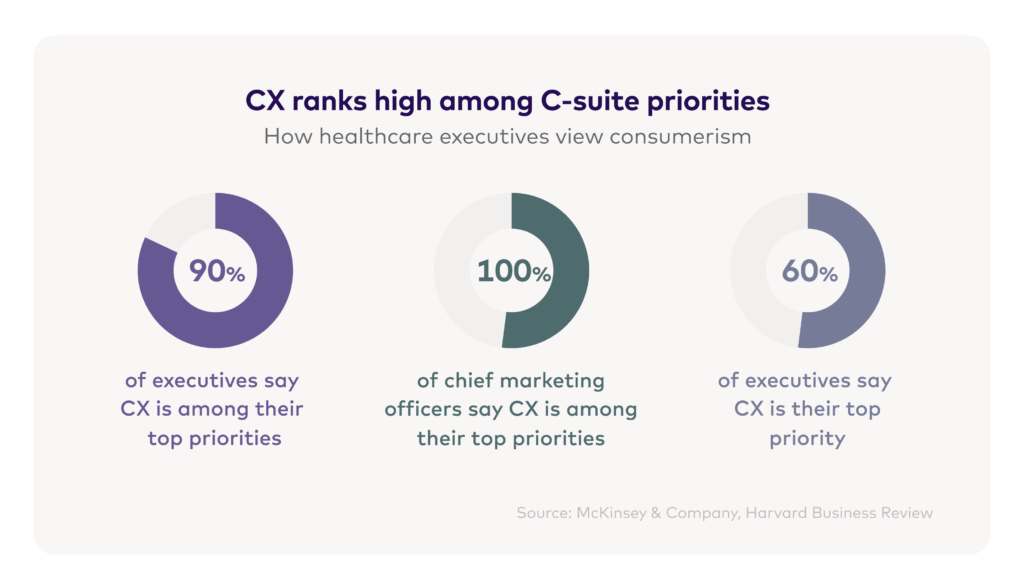The consumer experience (CX) bar has been raised by the likes of Amazon, Google, Netflix, Peloton, Uber and others — and today’s consumers now expect greater access, higher satisfaction and lower costs in healthcare as well. That reality leaves health plan and health system C-suites at a consumerism crossroads: effectively transform the member and patient experiences they offer or risk losing market share and revenue.
To that extent, CX has become a top C-suite priority, with 60% of healthcare executives considering it the No. 1 priority (see figure below). The business case is becoming increasingly clear. Transforming CX offers substantial opportunities to improve member and patient engagement and drive business objectives, such as expanding market share, improving operational efficiencies, reducing expenses, increasing revenue and improving health outcomes.

Turning a CX vision into reality, however, requires C-level leadership to understand where the organization needs to move and to drive the various business functions and people who lead them in that direction.
To achieve that objective, C-suites can take the following steps.
1. Develop a CX transformation strategy
Although the concept of consumer-centric care has been discussed for several years, Gartner predicts that half of large healthcare organizations will fail to adequately unify engagement channels by 2025.
A proven strategic path for accelerating the delivery of engaging experiences at scale exists in the form of care, cloud and CX: Moving data to the cloud to leverage resources for storage, compute, data management, advanced analytics, artificial intelligence (AI) and machine learning (ML); integrating point solutions and disparate information sources within a platform; and tying it all together into a CX layer to enable seamless, personalized health experiences.
2. Assemble and cultivate a care, cloud and CX team
Executives leading CX initiatives must build a team with comprehensive expertise in care, cloud and CX and understand the roles and skill sets necessary for success. This requires collaboration not only across the organization but throughout the ecosystem, as external partners can bring deep experience in data, engagement and personalization. Partnering with third parties that have built and retained cloud and CX talent will round out the skill set of the internal team to drive vision, strategy and accelerated innovation.
3. Align all relevant stakeholders
An effective transformation depends on a cross-departmental strategy that ensures each area of the business has the support it needs and a clear sense of direction. Often, large-scale digital transformations can become siloed and abstract, losing a sense of urgency and coherence. Defining a ‘why,’ or a North Star, that guides cross-functional change initiatives ensures that all stakeholders have a strategic understanding of their function within the larger CX transformation strategy.
4. Determine key performance indicators (KPIs)
CX transformation initiatives are data-intensive and produce results through a number of varied and multidisciplinary channels. This complexity requires health plans and health systems to have a well-defined purpose for their CX transformation goals to ensure success, and those goals must be tied to clear and tangible KPIs, such as market share, member or patient satisfaction, engagement, health outcomes and other outputs impacted by the transformation.
5. Prepare for scalability and repeatability
Executives should position their organizations to ultimately scale successful CX pilots from the outset. As is the case with other digital initiatives, scaling CX begins by charting a roadmap. This roadmap includes identifying where there’s an opportunity for demonstrable impact, adjusting practices as new learnings arise, highlighting successes to increase stakeholder buy-in and repeating the process across other business functions.
Leading CX transformation for C-suites
Executives embarking on CX transformation to address healthcare consumerism are undertaking the most significant technology and change management initiative the industry has seen in more than a decade.
For comprehensive, actionable insights on leveraging CX transformation to advance business objectives, download the C-Suite Guide to Leading Healthcare CX Transformation.

Your roadmap to CX success
Learn comprehensive insights for leading CX transformation efforts that drive results.
Sources
¹Driving growth through customer-centricity in healthcare, McKinsey & Company
²The customer experience in healthcare: new journeys ahead, Harvard Business Review
